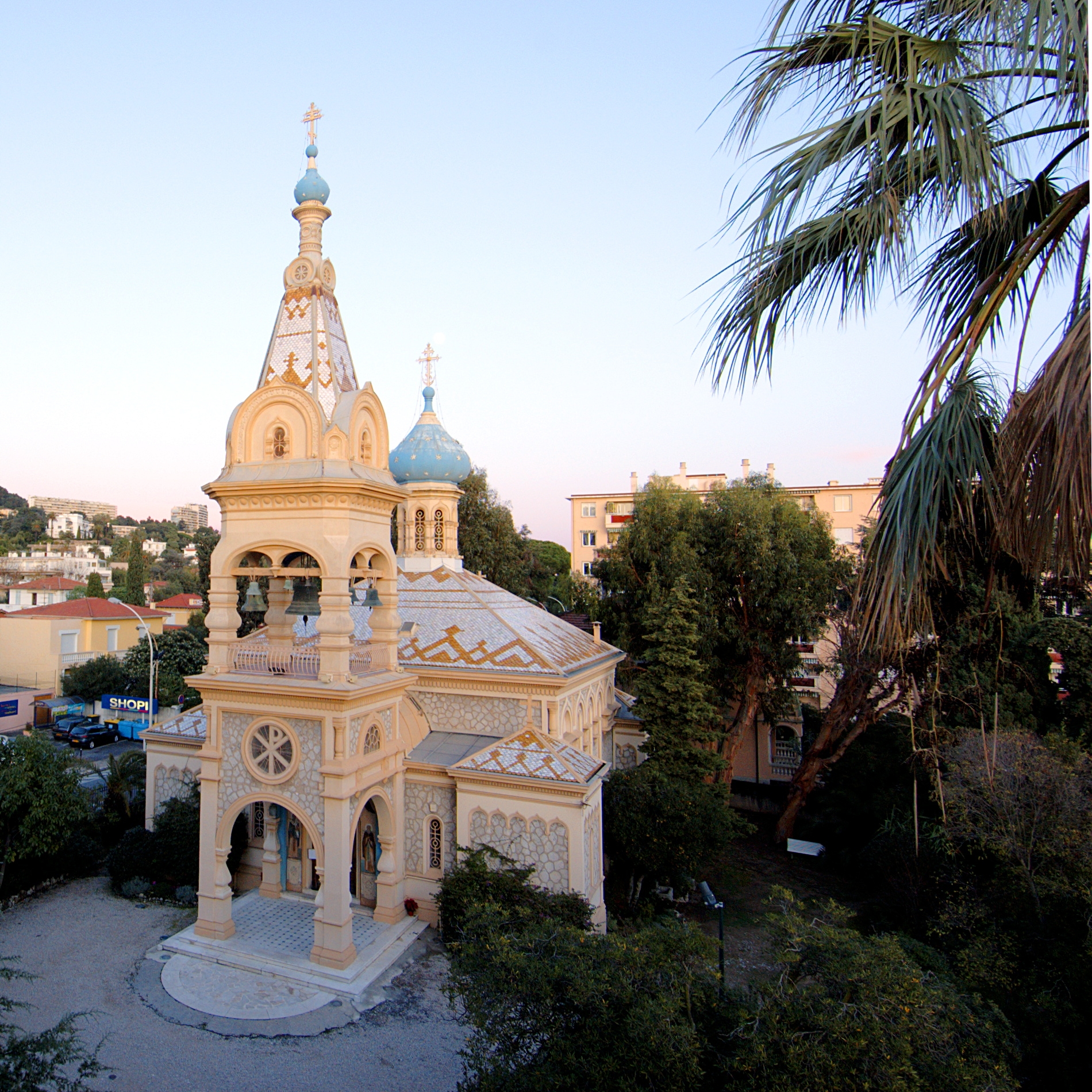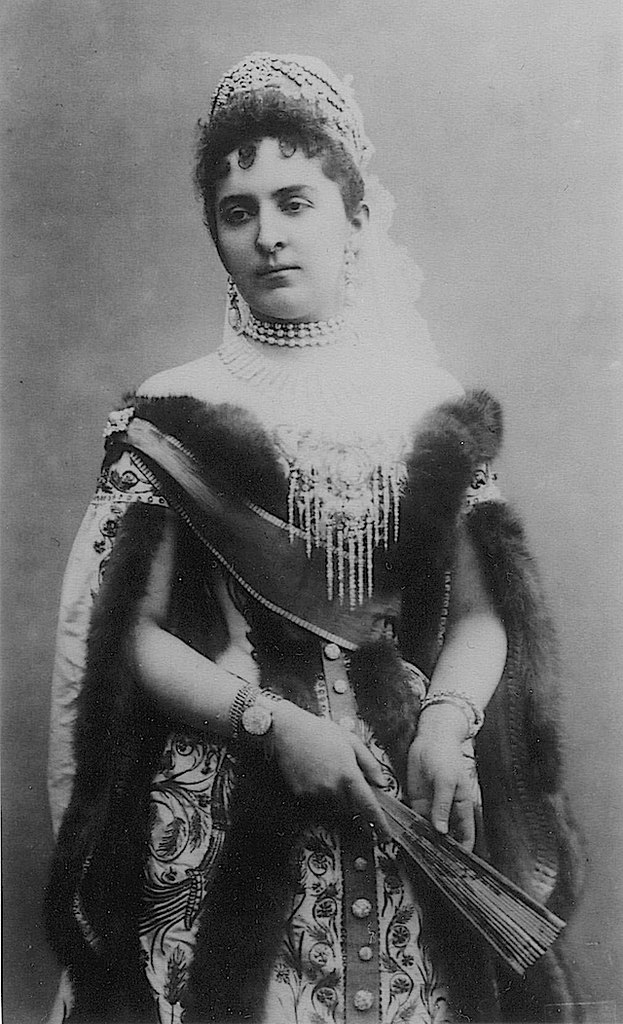|
St. Michael The Archangel Church (Cannes)
St. Michael the Archangel Church, Cannes is an Eastern Orthodox church in Cannes, France (40 Boulevard Alexandre III). It was built in 1894. The parish of the church has been, for most of its history, under the jurisdiction of the Archdiocese of Russian Orthodox churches in Western Europe, an exarchate of the Ecumenical Patriarchate of Constantinople from 1931 until November 2018; in September 2019, the parish switched to the jurisdiction of the Moscow Patriarchate. History The foundation of the church building was laid with the blessing of Metropolitan of St. Petersburg Palladiy (Raev) on 23 April (5 May) 1894. The building was designed by the architect Louis Nouveau. It was consecrated on 22 November (4 December) of the same year. The parish received donations from members of the Russian Imperial Family. After the inauguration of the church the Cannes municipality re-named the street where the church was located after Emperor Alexander III (boulevard Alexandre III) In 1921, ... [...More Info...] [...Related Items...] OR: [Wikipedia] [Google] [Baidu] |
Princess Anastasia Of Montenegro
Princess Anastasia Petrović-Njegoš of Montenegro (4 January Old_Style_and_New_Style_dates">O.S._23_December_1867.html" ;"title="Old_Style_and_New_Style_dates.html" ;"title="nowiki/> O.S._23_December_1867">Old_Style_and_New_Style_dates.html"_;"title="nowiki/>Old_Style_and_New_Style_dates">O.S._23_December_18671868_–_25_November_1935)_was_the_daughter_of_Nicholas_I_of_Montenegro.html" ;"title="Old Style and New Style dates">O.S. 23 December 1867">Old_Style_and_New_Style_dates.html" ;"title="nowiki/> O.S._23_December_18671868_–_25_November_1935)_was_the_daughter_of_Nicholas_I_of_Montenegro">King_Nikola_I_Petrović-Njegoš_of_Montenegro_(1841–1921)_and_his_wife,_O.S._23_December_18671868_–_25_November_1935)_was_the_daughter_of_Nicholas_I_of_Montenegro">King_Nikola_I_Petrović-Njegoš_of_Montenegro_(1841–1921)_and_his_wife,_Milena_of_Montenegro">Queen_Milena_(1847–1923).__Through_her_second_marriage,_she_became_Grand_Duchess_Anastasia_Nikolaevna_Romanova_of_Russia.__She ... [...More Info...] [...Related Items...] OR: [Wikipedia] [Google] [Baidu] |
Burial Sites Of The House Of Holstein-Gottorp-Romanov
Burial, also known as interment or inhumation, is a method of final disposition whereby a dead body is placed into the ground, sometimes with objects. This is usually accomplished by excavating a pit or trench, placing the deceased and objects in it, and covering it over. A funeral is a ceremony that accompanies the final disposition. Humans have been burying their dead since shortly after the origin of the species. Burial is often seen as indicating respect for the dead. It has been used to prevent the odor of decay, to give family members closure and prevent them from witnessing the decomposition of their loved ones, and in many cultures it has been seen as a necessary step for the deceased to enter the afterlife or to give back to the cycle of life. Methods of burial may be heavily ritualized and can include natural burial (sometimes called "green burial"); embalming or mummification; and the use of containers for the dead, such as shrouds, coffins, grave liners, and ... [...More Info...] [...Related Items...] OR: [Wikipedia] [Google] [Baidu] |
Buildings And Structures In Cannes
A building, or edifice, is an enclosed structure with a roof and walls standing more or less permanently in one place, such as a house or factory (although there's also portable buildings). Buildings come in a variety of sizes, shapes, and functions, and have been adapted throughout history for a wide number of factors, from building materials available, to weather conditions, land prices, ground conditions, specific uses, prestige, and aesthetic reasons. To better understand the term ''building'' compare the list of nonbuilding structures. Buildings serve several societal needs – primarily as shelter from weather, security, living space, privacy, to store belongings, and to comfortably live and work. A building as a shelter represents a physical division of the human habitat (a place of comfort and safety) and the ''outside'' (a place that at times may be harsh and harmful). Ever since the first cave paintings, buildings have also become objects or canvasses of much artistic ... [...More Info...] [...Related Items...] OR: [Wikipedia] [Google] [Baidu] |
Churches In Alpes-Maritimes
Church may refer to: Religion * Church (building), a building for Christian religious activities * Church (congregation), a local congregation of a Christian denomination * Church service, a formalized period of Christian communal worship * Christian denomination, a Christian organization with distinct doctrine and practice * Christian Church, either the collective body of all Christian believers, or early Christianity Places United Kingdom * Church (Liverpool ward), a Liverpool City Council ward * Church (Reading ward), a Reading Borough Council ward * Church (Sefton ward), a Metropolitan Borough of Sefton ward * Church, Lancashire, England United States * Church, Iowa, an unincorporated community * Church Lake, a lake in Minnesota Arts, entertainment, and media * ''Church magazine'', a pastoral theology magazine published by the National Pastoral Life Center Fictional entities * Church (''Red vs. Blue''), a fictional character in the video web series ''Red vs. Blue'' * Churc ... [...More Info...] [...Related Items...] OR: [Wikipedia] [Google] [Baidu] |
Princess Milica Of Montenegro
Princess Milica Petrović-Njegoš of Montenegro, also known as Grand Duchess Militza Nikolaevna of Russia, (14 July 1866 – 5 September 1951) was a Montenegrin princess. She was the daughter of King Nikola I Petrović-Njegoš of Montenegro and Milena Vukotić. Milica was the wife of Grand Duke Peter Nikolaevich of Russia, the younger brother of Grand Duke Nicholas Nikolaevich of Russia, whose wife was Milica's sister, Anastasia. Life Milica and her sister, Anastasia, were invited by Alexander III of Russia to be educated at the Russian Smolny Institute, which was a school for "noble maids". Grand Duke Peter Nikolaevich of Russia and Princess Milica were married on 26 July 1889 in Saint Petersburg. She was the first princess to marry in to the Imperial family who was already an Orthodox and did not need to convert in order to marry. She was described as well educated, intelligent and arrogant, and the opposite of her introverted spouse. Milica was an honorary doctor on a ... [...More Info...] [...Related Items...] OR: [Wikipedia] [Google] [Baidu] |
Grand Duke Peter Nikolaevich Of Russia
Grand Duke Peter Nikolaevich of Russia (Russian: Пётр Никола́евич Рома́нов; 22 January Old_Style_and_New_Style_dates">O.S._10_January.html" ;"title="Old_Style_and_New_Style_dates.html" ;"title="nowiki/>Old Style and New Style dates">O.S. 10 January">Old_Style_and_New_Style_dates.html" ;"title="nowiki/>Old Style and New Style dates">O.S. 10 January1864 – 17 June 1931) was a Russian Grand Duke and a member of the Russian Imperial Family. Early life and marriage Grand Duke Peter Nikolaevich was the second son of Grand Duke Nicholas Nikolaevich of Russia (1831-1891), Grand Duke Nicholas Nicolaievich the Elder (1831–1891) and Duchess Alexandra of Oldenburg (1838–1900). He was born in Saint Petersburg. As was the custom for Russian Grand Dukes (the title applied to all sons and grandsons of a Russian Emperor), the Grand Duke Peter served in the Russian army as a Lt.-General and Adjutant-General. On 26 July 1889, he married Princess Milica of Monte ... [...More Info...] [...Related Items...] OR: [Wikipedia] [Google] [Baidu] |
Duke Peter Alexandrovich Of Oldenburg
Duke Peter Alexandrovich of Oldenburg (21 November 1868 – 11 March 1924) was the first husband of Grand Duchess Olga Alexandrovna of Russia, the youngest sister of Tsar Nicholas II. Biography Early life He was born in Saint Petersburg in the Oldenburg Palace (present-day site of Saint-Petersburg State University of Culture and Arts), the only child of Duke Alexander Petrovich of Oldenburg (1844–1932) and Princess Eugenia Maximilianovna of Leuchtenberg (1845–1925). His mother was a granddaughter of Tsar Nicholas I of Russia through Nicholas's daughter, Grand Duchess Maria Nikolayevna, and his father was a great-grandson of Tsar Paul I of Russia through his paternal grandmother Grand Duchess Catherine Pavlovna. He was known by the name of "Petya".Phenix, p. 46 Marriage In 1900, he began to escort the 18-year-old Grand Duchess Olga Alexandrovna (1882–1960), the youngest daughter of the late Tsar Alexander III and younger sister to the reigning Tsar Nicholas II, to the th ... [...More Info...] [...Related Items...] OR: [Wikipedia] [Google] [Baidu] |
Memorial Park Complex Of The Heroes Of The First World War
Memorial park complex of the heroes of the First World War (russian: Мемориально-парковый комплекс героев Первой мировой войны) is a park in Moscow, Russia. It is located in the Sokol District of the Northern Administrative Okrug. The area of the park is 11.2 hectares. History Earlier there was the Moscow City Bratsky (Fraternal) Cemetery on the place of the park. The cemetery was founded in 1915 by the Grand Duchess Elizabeth Feodorovna. Almost 18,000 victims of the World War I were buried in the cemetery. In 1918 the Church of the Transfiguration was built here by the prominent architect Alexey Shchusev. In 1925 the Fraternal Cemetery was closed for burials. In 1932 it was turned into a park. All the tombstones, with the exception of one, were demolished. In the late 1940s the Church of the Transfiguration was demolished too. At the same time some blocks of buildings were built in the east part of the former cemetery. A cinema ... [...More Info...] [...Related Items...] OR: [Wikipedia] [Google] [Baidu] |
Grand Duke Nicholas Nikolaevich Of Russia (1856–1929)
Grand Duke Nicholas Nikolaevich of Russia (Russian: Николай Николаевич Романов (младший – ''the younger''); 18 November 1856 – 5 January 1929) was a Russian general in World War I (1914–1918). The son of Grand Duke Nicholas Nikolaevich of Russia (1831–1891), and a grandson of Emperor Nicholas I of Russia, he was commander in chief of the Imperial Russian Army units on the main front in the first year of the war, during the reign of his first cousin once removed, Nicholas II. Although held in high regard by Paul von Hindenburg, he struggled with the colossal task of leading Russia's war effort against Germany, including strategy, tactics, logistics and coordination with the government.Paul Robinson, "A Study of Grand Duke Nikolai Nikolaevich as Supreme Commander of the Russian Army, 1914–1915." ''Historian'' 75.3 (2013): 475-498online/ref> After the Gorlice–Tarnów offensive in 1915, Tsar Nicholas replaced the Grand Duke as commander ... [...More Info...] [...Related Items...] OR: [Wikipedia] [Google] [Baidu] |
Cannes
Cannes ( , , ; oc, Canas) is a city located on the French Riviera. It is a communes of France, commune located in the Alpes-Maritimes departments of France, department, and host city of the annual Cannes Film Festival, Midem, and Cannes Lions International Festival of Creativity. The city is known for its association with the rich and famous, its luxury hotels and restaurants, and for several conferences. History By the 2nd century BC, the Ligurian Oxybii established a settlement here known as ''Aegitna'' ( grc, Αἴγιτνα). Historians are unsure what the name means. The area was a fishing village used as a port of call between the Lérins Islands. In 154 Before Christ, BC, it became the scene of violent but quick conflict between the troops of Quintus Opimius and the Oxybii. In the 10th century, the town was known as Canua. The name may derive from "canna", a Reed (plant), reed. Canua was probably the site of a small Ligurian port, and later a Roman outpost on Le Suquet ... [...More Info...] [...Related Items...] OR: [Wikipedia] [Google] [Baidu] |
White émigré
White Russian émigrés were Russians who emigrated from the territory of the former Russian Empire in the wake of the Russian Revolution (1917) and Russian Civil War (1917–1923), and who were in opposition to the revolutionary Bolshevik communist Russian political climate. Many white Russian émigrés participated in the White movement or supported it, although the term is often broadly applied to anyone who may have left the country due to the change in regimes. Some white Russian émigrés, like Mensheviks and Socialist-Revolutionaries, were opposed to the Bolsheviks but had not directly supported the White Russian movement; some were apolitical. The term is also applied to the descendants of those who left and who still retain a Russian Orthodox Christian identity while living abroad. The term "émigré" is most commonly used in France, the United States, and the United Kingdom. A term preferred by the émigrés themselves was first-wave émigré (russian: link= no, эми ... [...More Info...] [...Related Items...] OR: [Wikipedia] [Google] [Baidu] |





